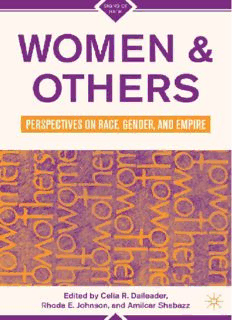
Women & Others: Perspectives on Race, Gender, and Empire PDF
Preview Women & Others: Perspectives on Race, Gender, and Empire
W O SIGNS OF RACE Series Editors: Phillip D. Beidler and Gary Taylor Writing Race across the Atlantic World: Medieval to Modern, edited by Phillip D. Beidler and Gary Taylor (January 2005) Buying Whiteness: Race, Culture, and Identity from Columbus to Hip-Hop, by Gary Taylor (January 2005) English and Ethnicity, edited by Janina Brutt-Griffler and Catherine Evans Davies (December 2006) Women & Others: Perspectives on Race, Gender, and Empire, edited by Celia R. Daileader, Rhoda E. Johnson, and Amilcar Shabazz (September 2007) W O , P R , G E Edited by Celia R. Daileader, Rhoda E. Johnson, and Amilcar Shabazz WOMEN& OTHERS Copyright © Celia R.Daileader,Rhoda E.Johnson,and Amilcar Shabazz,2007. All rights reserved.No part of this book may be used or reproduced in any manner whatsoever without written permission except in the case of brief quotations embodied in critical articles or reviews. First published in 2007 by PALGRAVE MACMILLAN™ 175 Fifth Avenue,New York,N.Y.10010 and Houndmills,Basingstoke,Hampshire,England RG21 6XS Companies and representatives throughout the world. PALGRAVE MACMILLAN is the global academic imprint of the Palgrave Macmillan division of St.Martin’s Press,LLC and of Palgrave Macmillan Ltd. Macmillan® is a registered trademark in the United States,United Kingdom and other countries.Palgrave is a registered trademark in the European Union and other countries. ISBN 978-0-312-29602-5 ISBN 978-0-230-60732-3 (eBook) DOI 10.1057/9780230607323 Library of Congress Cataloging-in-Publication Data is available from the Library of Congress. A catalogue record for this book is available from the British Library. Design by Newgen Imaging Systems (P) Ltd.,Chennai,India. First edition:September 2007 10 9 8 7 6 5 4 3 2 1 This book is dedicated to our memories of three extraordinary women: Sylvia Elliott (1937–2005) Cynthia Malara (1968–2006) Ute Brosche Winston (1939–2006) For all those we love for whom tomorrow will not be another day, we send the sweet prayer of resting in peace. —Alice Randall, The Wind Done Gone This page intentionally left blank C Series Editors’ Preface ix Philip D. Beidler and Gary Taylor Acknowledgments xiii Notes on the Contributors xv Who Is the Other Woman? An Introduction 1 Celia R. Daileader Part I Literatures 1 Miscegenation as Consolation in George Colman’s Inkle and Yarico 25 Joyce Green MacDonald 2 Fear of Family, Fear of Self: Black Southern “Othering” in Randall Kenan’s A Visitation of Spirits 45 Trudier Harris 3 Looking for Love in All the Wrong Places: Same-Sex Relations in the Fiction of Gloria Naylor 67 Maxine Lavon Montgomery 4 Postmodernism, Paul Auster’s The New York Trilogy,and the Construction of the Black/Woman of Color as Primal Other 83 Lawrence W. Hogue viii C Part II Histories 5 The Memsahib Myth: Englishwomen in Colonial India 107 Indira Ghose 6 Race, Gender, and Leadership: (En)Countering Discourses that Devalue African American Women as Leaders 129 Patricia S. Parker 7 Gender, Race, and Sexuality in the American Christian Right 147 Andrea Smith 8 The Future of Feminism: What Other Way to Speak? 173 Vron Ware List of Abbreviations 197 Index 199 S E ’ P I have never been to Alabama before, but it is and will forever remain seared in my memory as the place where black Americans challenged America to live up to the meaning of her creed so as not to make a mockery of her ideals. —August Wilson (September 26, 2001) T he first thing you see when you enter the permanent exhibits at the Birmingham Civil Rights Institute is a pair of drinking fountains. Over one hangs a sign that says “White.” Over the other hangs a sign that says “Colored.” As an inquiry into the cultural history of race, the series “Signs of Race” has its own obvious historical origins. It springs from a series of symposiums at the University of Alabama—the place where George Wallace made segregation’s last stand. But the series finds its larger cultural and intellectual impulses in a deeper and wider history that surrounds us here. Black, brown, red, and white; African American and Afro-Caribbean; English, French, and Spanish; Celtic and Jewish; native American and northern European, creole and mestizo: such cultural categories, wherever they are found, in whatever combina- tions, and in whatever arrangements of historical interaction and transmission, constitute the legacy of the oceanic intercultures of race in the early modern era. In Alabama, the very landscape is steeped in such history. Twenty miles to the south of the town of Tuscaloosa, the home of the university, is a vast city of pre-Columbian mounds, the capital of a Mississippian empire that flourished at the time of the Norman Conquest and then disappeared two centuries later. The town of Tuscaloosa itself is named after a great chief of the Alabamas, known as the Black Warrior, who engaged the Spanish explorer DeSoto in the 1540 battle of Maubila, to this day thought to be the largest single combat ever fought by native Americans against Europeans. The European settlement of the Gulf Coast pitted English, French, Spanish, and American colonizers against each other well into the nineteenth century. The Revolutionary War found native
Description: